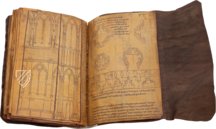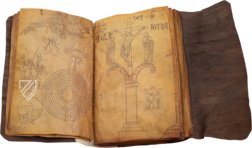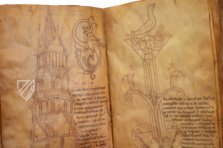Book of Cathedrals
(3,000€ - 7,000€)
This mysterious fragment of a 13th century manuscript represents the most important architectural treatise of the High Middle Ages. El Libro de las Catedrales is an encyclopedic text that covers masonry, architecture, surveying, carpentry, geometry, zoology, and contemporary mechanical devices related to the exciting and mysterious art of cathedral construction. Almost nothing is known about the text or its author, Villard de Honnecourt, other than that, judging by his name and dialect of Old French, he likely originated from France’s Picardy region. Nonetheless, this is considered to be one of the most important manuscripts to survive the 13th century, and Honnecourt has even been considered to be a forerunner to the Renaissance polymath Leonardo da Vinci.
Villard de Honnecourt: The Book of Cathedrales
"Villard de Honnecourt greets you and recommends to all those who use the instructions given in this book to pray for their souls and remember them, because in this book you will find useful help for the magnificent art of construction and some carpentry arts and also the art of portraiture and its components as required and taught the art of geometry."
So begins this unique 13th century manuscript, the most important architectural treatise of the High Middle Ages. The Book of Cathedrals, also known as Album de dessins et croquis (“Album of Drawings and Sketches”) is an encyclopedic text that covers masonry, architecture, surveying, carpentry, geometry, zoology, and contemporary mechanical devices related to the exciting and mysterious art of cathedral construction. These subjects are illustrated by 250 diagrams across 66 pages and the character of the architectures depicted indicate that Honnecourt visited cathedrals in France, Switzerland, and Hungary inter alia. All this is found in a comprehensive document that is only a fragment of a manuscript that originated ca. 1225–35 and was rediscovered in the 19th century. Today, it is housed among the collections of the Bibliothèque nationale de France under the shelf mark Français 19093 and is considered to be one of the most important written works to survive the 13th century.
A Mysterious High Medieval Polymath
Villard de Honnecourt was an enigmatic medieval polymath considered by many to be a forerunner of the great Leonardo da Vinci. That being said, little is known about this medieval personality, in fact, this is the only document attesting to his existence. His name has appeared as both “Villars” and “Vilars” while his surname and the dialect of Old French he uses indicate that he was from Picardy in France, specifically from an area known as Honnecourt-sur-Escaut that evolved around a Benedictine abbey. He depicts himself both as a soldier and as a master builder, so it may be that his designs for military equipment were inspired by practical experience in war. In the High Middle Ages, sieges were the defining feature of war, overcoming stone fortifications required either a great deal of patience. Without innovative machines like siege towers and trebuchets, one had to resort to time-consuming tactics like starving out the defenders or undermining walls. As such, the high medieval theater of war was far more technical than we think of today and would have provided plenty of demand for proto-engineers like Honnecourt. That being said, it is unlikely that he was active as an architect due to inaccuracies and misunderstandings in his work that one would not expect from a professional architect. Therefore, Honnecourt was likely an amateur architect who worked in a related profession that would have required some knowledge of arithmetic and geometry. Of course all of this is speculation because so little is known about both the work and its author.
Innovative Machinery
Honnecourt was the first European to devise a perpetual motion machine. In a time without electricity and other forms of power, such a devise would have been a miracle for the medieval construction site. However, Leonardo da Vinci was already skeptical of such devices during the Renaissance, and we know today that perpetual motion machines are impossible because they violate the first two laws of thermodynamics. Nevertheless, they continue to be a source of fascination today. He also designed automata, pseudo-robots that were popular in the Middle Ages both as curiosities and demonstrations of wealth and sophistication. The most famous examples thereof were in Constantinople: the throne room of the Byzantine emperors had gilded automata such as a tree full of singing birds, roaring lions, and a throne that could be raised and lowered – all to impress visitors with their status as the heirs of the Roman Empire. Honnecourt’s manuscript contains diagrams of lifting devices, water-driven saws, a trebuchet, and other engines of war that appear to be practical, even if their diagrams are simplistic and sometimes inaccurate. It may be that the diagrams were kept simple in order to make them only accessible to those initiated in the secrets of architecture and engineering, but again, this is only speculation.
Codicology
- Alternative Titles
- Buch der Kathedralen
El Libro de las Catedrales
Sketchbook of Villard de Honnecourt
Villard de Honnecourt, Album de dessins et croquis
El Libro de las Catedrales
Le carnet de Villard de Honnecourt
Cuaderno de Bocetos de Villard de Honnecourt
The Portfolio of Villard de Honnecourt - Size / Format
- 66 pages / 23.2 × 15.2 cm
- Origin
- France
- Date
- Around 1220
- Epochs
- Style
- Language
- Illustrations
- Over 250 great illustrations covering all the themes of the work
- Content
- The Book of Cathedrales is an almost encyclopedic work that covers masonry, architecture, surveying, carpentry, geometry, zoology, and contemporary mechanical devices related to the exciting and mysterious art of cathedral construction.
- Artist / School
- Villard de Honnecourt
- Previous Owners
- Jehanne Martian
J. Mancel
André Félibien
Book of Cathedrals
Men with Tendril Beards and Hair
While travelling throughout Europe visiting cathedrals, Villard de Honnecourt doubtless saw many fine examples stonemasonry including fine carved figures. Here we see the faces of two hairy, bearded men, but their hair follicles have been replaced by leafy tendrils. Both are arranged artfully, the left having upturned leaves and the right downturned. Perhaps these highly stylized human faces looked out at Honnecourt from the stone relief or a cathedral or abbey in the course of his travels.

The Book of Cathedrals
Study of Windows Behind an Altar
This 13th century study depicts the windows that typically frame the altar in the east end of a cathedral and attempts to use perspective to show how the two outer windows flank the center. That this is a Gothic cathedral is evidenced by the large windows with pointed arches and stone tracery made possible by the flying buttresses outside (not pictured).
Lighter weight vaulting and stone ribs contributed to the brighter, more elegant aesthetic created by the larger windows of Gothic churches. Tall windows of this type usually lined the aisles of a Gothic cathedral but were sometimes arranged thusly to frame an altar and allow it to receive light from as many directions as possible. Villard de Honnecourt’s notes and instructions fill the margins.

#1 El Libro de las Catedrales
Language: Spanish
(3,000€ - 7,000€)
- Treatises / Secular Books
- Apocalypses / Beatus
- Astronomy / Astrology
- Bestiaries
- Bibles / Gospels
- Chronicles / History / Law
- Geography / Maps
- Saints' Lives
- Islam / Oriental
- Judaism / Hebrew
- Single Leaf Collections
- Leonardo da Vinci
- Literature / Poetry
- Liturgical Manuscripts
- Medicine / Botany / Alchemy
- Music
- Mythology / Prophecies
- Psalters
- Other Religious Books
- Games / Hunting
- Private Devotion Books
- Other Genres
- Afghanistan
- Armenia
- Austria
- Belgium
- Belize
- Bosnia and Herzegovina
- China
- Colombia
- Costa Rica
- Croatia
- Cyprus
- Czech Republic
- Denmark
- Egypt
- El Salvador
- Ethiopia
- France
- Germany
- Greece
- Guatemala
- Honduras
- Hungary
- India
- Iran
- Iraq
- Israel
- Italy
- Japan
- Jordan
- Kazakhstan
- Kyrgyzstan
- Lebanon
- Liechtenstein
- Luxembourg
- Mexico
- Morocco
- Netherlands
- Palestine
- Panama
- Peru
- Poland
- Portugal
- Romania
- Russia
- Serbia
- Spain
- Sri Lanka
- Sweden
- Switzerland
- Syria
- Tajikistan
- Turkey
- Turkmenistan
- Ukraine
- United Kingdom
- United States
- Uzbekistan
- Vatican City
- A. Oosthoek, van Holkema & Warendorf
- Aboca Museum
- Ajuntament de Valencia
- Akademie Verlag
- Akademische Druck- u. Verlagsanstalt (ADEVA)
- Aldo Ausilio Editore - Bottega d’Erasmo
- Alecto Historical Editions
- Alkuin Verlag
- Almqvist & Wiksell
- Amilcare Pizzi
- Andreas & Andreas Verlagsbuchhandlung
- Archa 90
- Archiv Verlag
- Archivi Edizioni
- Arnold Verlag
- ARS
- Ars Magna
- ArtCodex
- AyN Ediciones
- Azimuth Editions
- Badenia Verlag
- Bärenreiter-Verlag
- Belser Verlag
- Belser Verlag / WK Wertkontor
- Benziger Verlag
- Bernardinum Wydawnictwo
- BiblioGemma
- Biblioteca Apostolica Vaticana (Vaticanstadt, Vaticanstadt)
- Bibliotheca Palatina Faksimile Verlag
- Bibliotheca Rara
- Boydell & Brewer
- Bramante Edizioni
- Bredius Genootschap
- Brepols Publishers
- British Library
- C. Weckesser
- Caixa Catalunya
- Canesi
- CAPSA, Ars Scriptoria
- Caratzas Brothers, Publishers
- Carus Verlag
- Casamassima Libri
- Centrum Cartographie Verlag GmbH
- Chavane Verlag
- Christian Brandstätter Verlag
- Circulo Cientifico
- Club Bibliófilo Versol
- Club du Livre
- CM Editores
- Collegium Graphicum
- Collezione Apocrifa Da Vinci
- Comissão Nacional para as Comemorações dos Descobrimentos Portugueses
- Coron Verlag
- Corvina
- CTHS
- D. S. Brewer
- Damon
- De Agostini/UTET
- De Nederlandsche Boekhandel
- De Schutter
- Deuschle & Stemmle
- Deutscher Verlag für Kunstwissenschaft
- DIAMM
- Droz
- E. Schreiber Graphische Kunstanstalten
- Ediciones Boreal
- Ediciones Grial
- Ediclube
- Edições Inapa
- Edilan
- Editalia
- Edition Deuschle
- Edition Georg Popp
- Edition Leipzig
- Edition Libri Illustri
- Editiones Reales Sitios S. L.
- Éditions de l'Oiseau Lyre
- Editions Medicina Rara
- Editorial Casariego
- Editorial Mintzoa
- Editrice Antenore
- Editrice Velar
- Edizioni Edison
- Egeria, S.L.
- Eikon Editores
- Electa
- Emery Walker Limited
- Enciclopèdia Catalana
- Eos-Verlag
- Ephesus Publishing
- Ernst Battenberg
- Eugrammia Press
- Extraordinary Editions
- Fackelverlag
- Facsimila Art & Edition
- Facsimile Editions Ltd.
- Facsimilia Art & Edition Ebert KG
- Faksimile Verlag
- Feuermann Verlag
- Folger Shakespeare Library
- Franco Cosimo Panini Editore
- Friedrich Wittig Verlag
- Fundación Hullera Vasco-Leonesa
- G. Braziller
- Gabriele Mazzotta Editore
- Gebr. Mann Verlag
- Gesellschaft für graphische Industrie
- Getty Research Institute
- Giovanni Domenico de Rossi
- Giunti Editore
- Graffiti
- Grafica European Center of Fine Arts
- Guido Pressler
- Guillermo Blazquez
- Gustav Kiepenheuer
- H. N. Abrams
- Harrassowitz
- Harvard University Press
- Helikon
- Hendrickson Publishers
- Henning Oppermann
- Herder Verlag
- Hes & De Graaf Publishers
- Hoepli
- Holbein-Verlag
- Houghton Library
- Hugo Schmidt Verlag
- Idion Verlag
- Il Bulino, edizioni d'arte
- ILte
- Imago
- Insel Verlag
- Insel-Verlag Anton Kippenberger
- Instituto de Estudios Altoaragoneses
- Instituto Nacional de Antropología e Historia
- Introligatornia Budnik Jerzy
- Istituto dell'Enciclopedia Italiana - Treccani
- Istituto Ellenico di Studi Bizantini e Postbizantini
- Istituto Geografico De Agostini
- Istituto Poligrafico e Zecca dello Stato
- Italarte Art Establishments
- Jan Thorbecke Verlag
- Johnson Reprint Corporation
- Josef Stocker
- Josef Stocker-Schmid
- Jugoslavija
- Karl W. Hiersemann
- Kasper Straube
- Kaydeda Ediciones
- Kindler Verlag / Coron Verlag
- Kodansha International Ltd.
- Konrad Kölbl Verlag
- Kurt Wolff Verlag
- La Liberia dello Stato
- La Linea Editrice
- La Meta Editore
- Lambert Schneider
- Landeskreditbank Baden-Württemberg
- Leo S. Olschki
- Les Incunables
- Liber Artis
- Library of Congress
- Libreria Musicale Italiana
- Lichtdruck
- Lito Immagine Editore
- Lumen Artis
- Lund Humphries
- M. Moleiro Editor
- Maison des Sciences de l'homme et de la société de Poitiers
- Manuscriptum
- Martinus Nijhoff
- Maruzen-Yushodo Co. Ltd.
- MASA
- Massada Publishers
- McGraw-Hill
- Metropolitan Museum of Art
- Militos
- Millennium Liber
- Müller & Schindler
- Nahar - Stavit
- Nahar and Steimatzky
- National Library of Wales
- Neri Pozza
- Nova Charta
- Oceanum Verlag
- Odeon
- Orbis Mediaevalis
- Orbis Pictus
- Österreichische Staatsdruckerei
- Oxford University Press
- Pageant Books
- Parzellers Buchverlag
- Patrimonio Ediciones
- Pattloch Verlag
- PIAF
- Pieper Verlag
- Plon-Nourrit et cie
- Poligrafiche Bolis
- Presses Universitaires de Strasbourg
- Prestel Verlag
- Princeton University Press
- Prisma Verlag
- Priuli & Verlucca, editori
- Pro Sport Verlag
- Propyläen Verlag
- Pytheas Books
- Quaternio Verlag Luzern
- Reales Sitios
- Recht-Verlag
- Reichert Verlag
- Reichsdruckerei
- Reprint Verlag
- Riehn & Reusch
- Roberto Vattori Editore
- Rosenkilde and Bagger
- Roxburghe Club
- Salerno Editrice
- Saltellus Press
- Sandoz
- Sarajevo Svjetlost
- Schöck ArtPrint Kft.
- Schulsinger Brothers
- Scolar Press
- Scrinium
- Scripta Maneant
- Scriptorium
- Shazar
- Siloé, arte y bibliofilia
- SISMEL - Edizioni del Galluzzo
- Sociedad Mexicana de Antropología
- Société des Bibliophiles & Iconophiles de Belgique
- Soncin Publishing
- Sorli Ediciones
- Stainer and Bell
- Studer
- Styria Verlag
- Sumptibus Pragopress
- Szegedi Tudomànyegyetem
- Taberna Libraria
- Tarshish Books
- Taschen
- Tempus Libri
- Testimonio Compañía Editorial
- Thames and Hudson
- The Clear Vue Publishing Partnership Limited
- The Facsimile Codex
- The Folio Society
- The Marquess of Normanby
- The Richard III and Yorkist History Trust
- Tip.Le.Co
- TouchArt
- TREC Publishing House
- TRI Publishing Co.
- Trident Editore
- Tuliba Collection
- Typis Regiae Officinae Polygraphicae
- Union Verlag Berlin
- Universidad de Granada
- University of California Press
- University of Chicago Press
- Urs Graf
- Vallecchi
- Van Wijnen
- VCH, Acta Humaniora
- VDI Verlag
- VEB Deutscher Verlag für Musik
- Verlag Anton Pustet / Andreas Verlag
- Verlag Bibliophile Drucke Josef Stocker
- Verlag der Münchner Drucke
- Verlag für Regionalgeschichte
- Verlag Styria
- Vicent Garcia Editores
- W. Turnowski Ltd.
- W. Turnowsky
- Waanders Printers
- Wiener Mechitharisten-Congregation (Wien, Österreich)
- Wissenschaftliche Buchgesellschaft
- Wissenschaftliche Verlagsgesellschaft
- Wydawnictwo Dolnoslaskie
- Xuntanza Editorial
- Zakład Narodowy
- Zollikofer AG































































